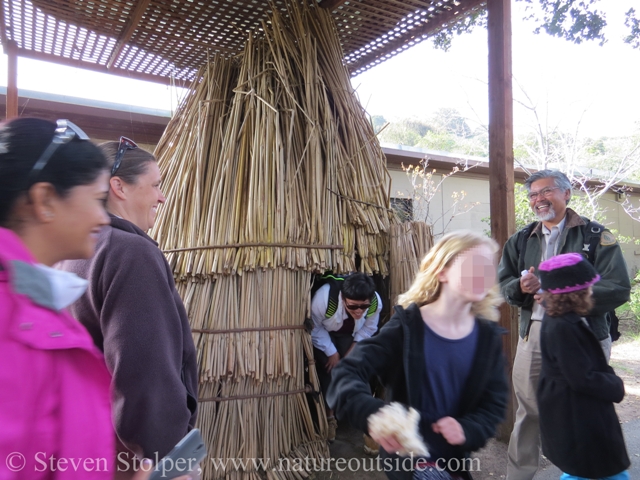
Imagine going back in time 475 years.
It is the year 1540. You are a Native Californian living along the coast of what is now called San Francisco Bay. You wake before dawn and rise from your tule sleeping mat. As you glide through the dark interior of your pit house, you inhale the smoke from a slow burning fire. Once outside, you survey the surrounding marshland. An expectant silence fills the moments before dawn. There is much to do…
The First Peoples of California
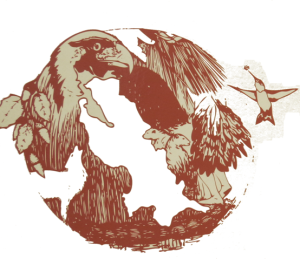 When European explorers reached California in 1542, they found a land populated by more than 300,000 people. California held the most diverse native cultural groups of any state, or in fact country of comparable geographic size.1 North of Mexico City, California was the most densely populated region in North America.1
When European explorers reached California in 1542, they found a land populated by more than 300,000 people. California held the most diverse native cultural groups of any state, or in fact country of comparable geographic size.1 North of Mexico City, California was the most densely populated region in North America.1
Anthropologists estimate that people lived in California at least 12,000 years before European contact. But much of their cultural knowledge and identity was lost during subsequent centuries of persecution and disease brought by the Spanish, and later the Americans.
But there are places you can visit to learn about the first peoples of California.
Coyote Hills
I’ve mentioned previously that you get more out of volunteering than you put in. The training you receive as a volunteer is a prime example.
This summer I will lead hikes and workshops at Don Edwards San Francisco Bay National Wildlife Refuge. As part of volunteer training, Don Edwards docents visited Coyote Hills Regional Park to learn about the Ohlone Peoples who inhabited the Bay Area.
The Tuibun Ohlone
Coyote Hills is special because the park contains the site of the ancient village of Tuibun (pronounced “too-ee-bun”). Archaeologists think the village may be more than 2,000 years old.
The Tuibun were one of the many Ohlone tribes who lived between San Francisco and Monterey, California. Collectively the region’s inhabitants are referred to as Ohlone. But this is a modern designation based on language relationships rather than political boundaries. About 57 politically independent, multi-village tribes spoke Ohlone dialects. These included the Tuibun of Coyote Hills.
Environment
I was eager to learn about the Tuibun because of where they lived. The village site sits within one of the vast freshwater marshes that surrounded San Francisco Bay. I wondered what it was like to live in a marsh environment, and how the people used the plants and animals around them.
San Francisco Bay looks nothing like it did before European contact. Industrial buildings have replaced the vast marshlands. The rocky bottom of the bay is covered in silt washed down from the Sierras by hydraulic gold mining.
So Coyote Hills and Don Edwards are some of the few places you can visit to get a feeling of what San Francisco Bay was like so many years ago. Naturalists at Coyote Hills lead tours of the village site twice each month.
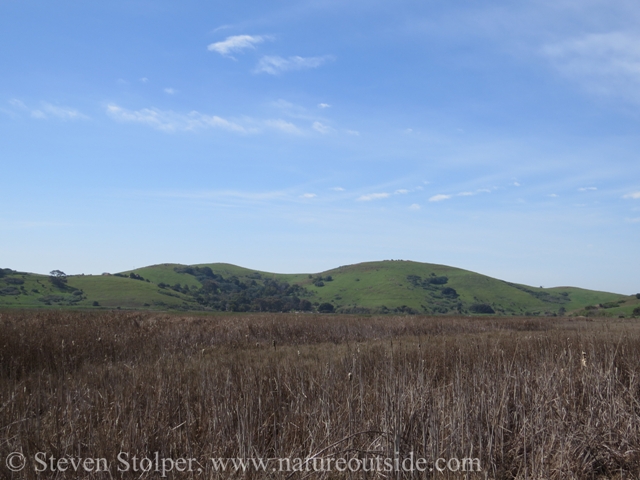
Fields of dry tule cover a freshwater marsh beneath the Coyote Hills. On the other side is San Francisco Bay.
The Tule House
Tremendous stands of Tule reeds (Schoenoplectus acutus) dominated the freshwater marshes. They formed inconceivably thick jungles of rich green. As the seasons advance, the plants turn a warm golden color as they dry.
Tules can grow to a height of eight to ten feet along stream banks. But they can reach fifteen or twenty feet tall in marshes. These important plants provide habitat for many species of birds and mammals. Tules also play an important ecological role. They help buffer against wind and water erosion along shorelines.
Tule is also a versatile building material. The indigenous peoples of California used it for baskets, clothing, mats, dolls and toys, duck decoys, and even rafts and boats.2 When I see tule boats and other items I am always impressed by the craftsmanship of the people who made them.
One of its most fascinating uses is to build shelters. During our visit to Coyote Hills, we were able to explore a replica tule house in front of the visitor center.
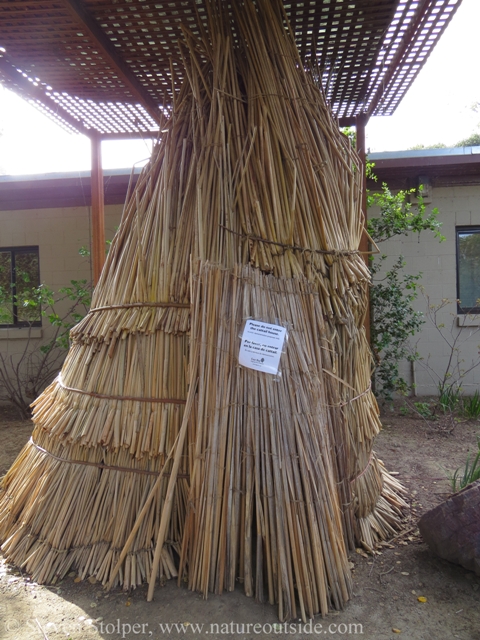
Tule house replica (door closed)
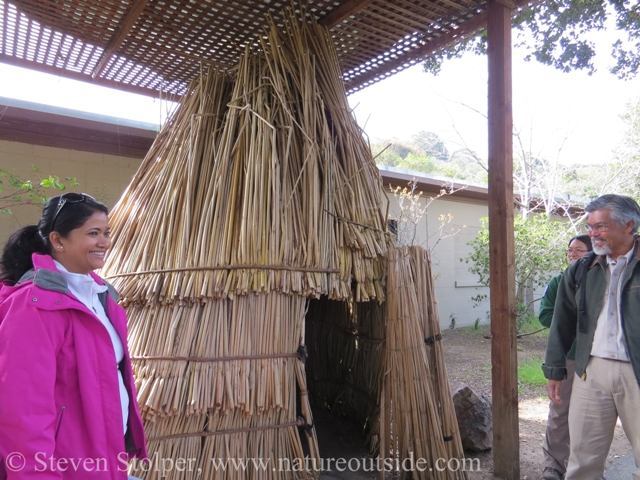
Tule house replica (door open).
The house has a conical framework made from concentric rings of bent willow branches. In many ways the frame reminds me of a wikiup. Starting from the bottom, tule stems are laid against the willow frame and sandwiched between another ring of bent willow on the outside of the structure. The two rings are cinched together tightly with willow bark strips. Construction starts at the bottom so each higher level of tule is shingled on top of the layer below. This helps shed water from rain.
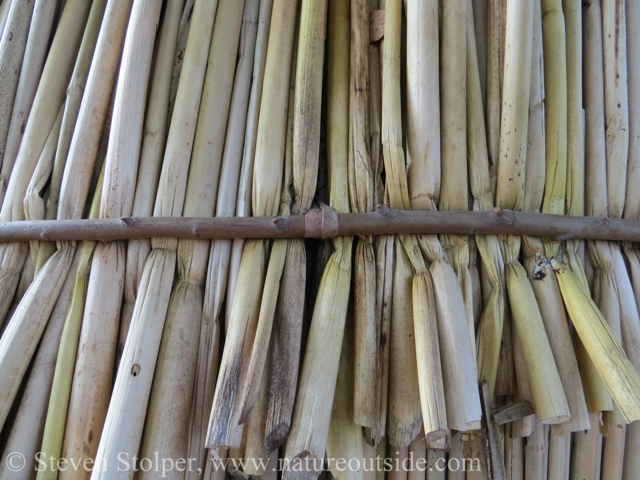
Tule house exterior. The bent willow hoop sandwiches the tule stems against a hoop in the interior. You can see the willow bark strip that cinches the two hoops together.
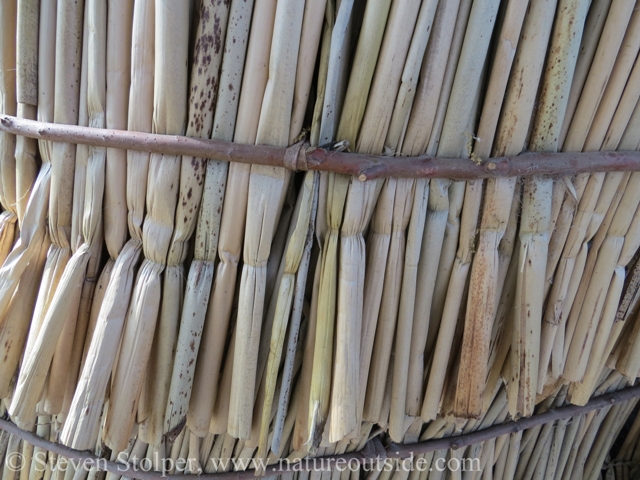
Tule house exterior. You can see how the upper layer of tule overlaps the lower one. This helps shed rain.
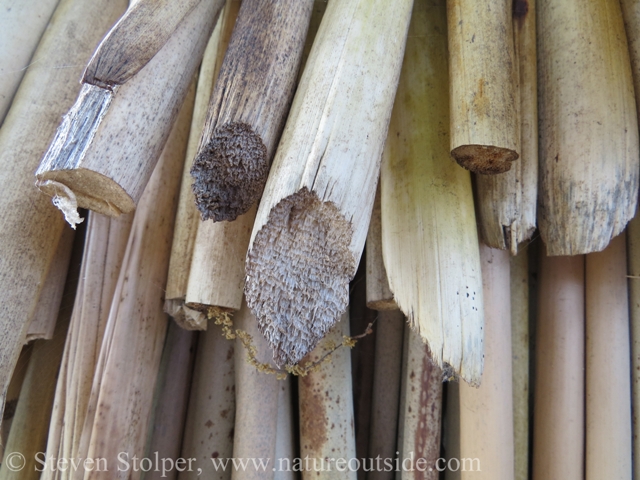
Tule has a spongy interior.
A Boy Scout made this tule house for his Eagle Scout service project. The walls are much too thin to be weatherproof. Tule houses of the past had thicker walls to insulate its occupants from rain and cold.
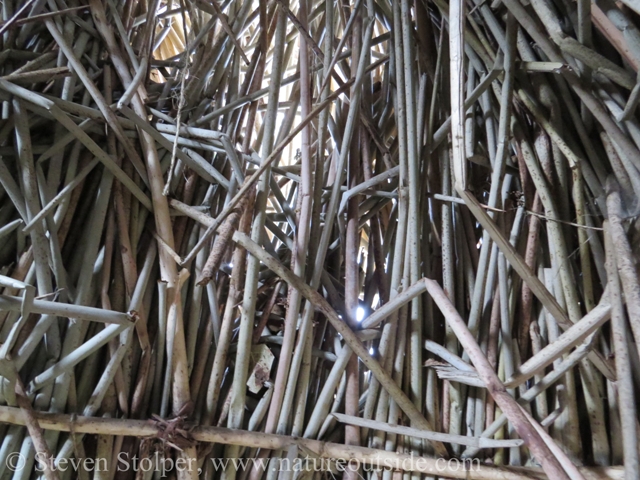
Tule house interior wall. You can see the willow frame lashed together. We should not be able to see through the walls. They should be much thicker.
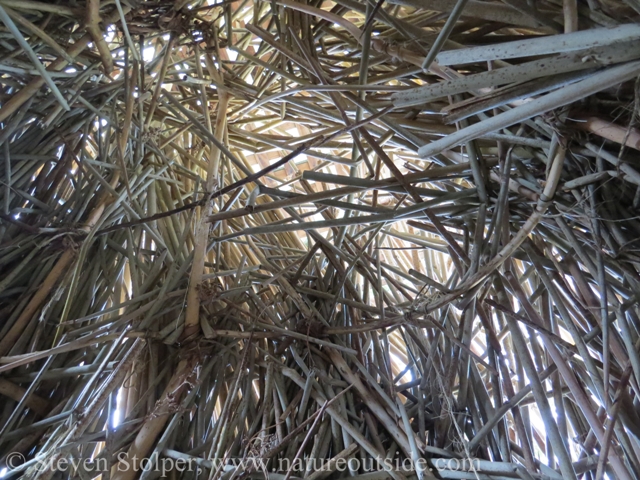
Tule house interior roof. The willow hoops get smaller closer to the top of the structure. The roof should be thicker and opaque.
I was puzzled. The house is a closed dome without a chimney hole. Remember, an actual tule house has much thicker walls than the replica. How can you burn a heating fire to warm its interior? Wouldn’t the smoke choke the occupants?
Dino, our guide, had similar questions. In another tule structure he lit a smoky fire. He covered the fire with green branches to produce billows of white smoke. He explained that air entering through the door creates a chimney effect. Convection causes the smoke to rise. To Dino’s amazement, the smoke passed right through the tule roof! I wish I could have witnessed it. He stood comfortably inside without being inundated by smoke. What a clever design!
Dino explained that regular warming fires dry the structure after rains and fend off mold and mildew. Since the park does not kindle fires in its tule house, he worries that its structure will eventually succumb to mold.
I have made tule baskets before so I am familiar with how to use the material. You dry the reeds after you harvest them, for storage. When you are ready, soak them in water to make them pliable. You can then work the tule to create your basket or other useful item.
Hiking to the Site
After exploring the tule house, we hiked to the Tiubun village archaeological site. We passed an “ethnobotany garden” where our guide, Dino, grew culturally important plants. He planted tule in plastic pots to retain water near their roots. This allowed him to grow the water-loving tule in an otherwise dry garden.
Beside the garden grew California Buckeye (Aesculus californica) and Blue Elderberry (Sambucus cerulea). Both are preferred hand-drill materials. Local people used buckeye for the hearth-boards with Elderberry spindles.
We hiked through the marsh on raised walkways under overcast skies. The morning temperature reached a pleasant 65 degrees and a gentle breeze swayed the tule rhythmically. As we progressed through the marsh, the clouds gave way to a serene blue sky interrupted only by wispy high altitude clouds.
The cacophony of bird calls was astounding. It surprised me that the birds kept singing even as our group trudged past. Approaching a bird usually causes it to stop singing. I suspect they felt confident inside the cover of the tule.
As we hiked, our discussion shifted to cordage. Dino pointed out some dried nettle stems. He grabbed one of the stems, flattened it and removed the bast fibers. He leg-rolled some stinging nettle cordage faster than I can say “stinging nettle cordage.” I have seen Dino do this before and am always impressed by his technique.
Finally, we reached the village site.
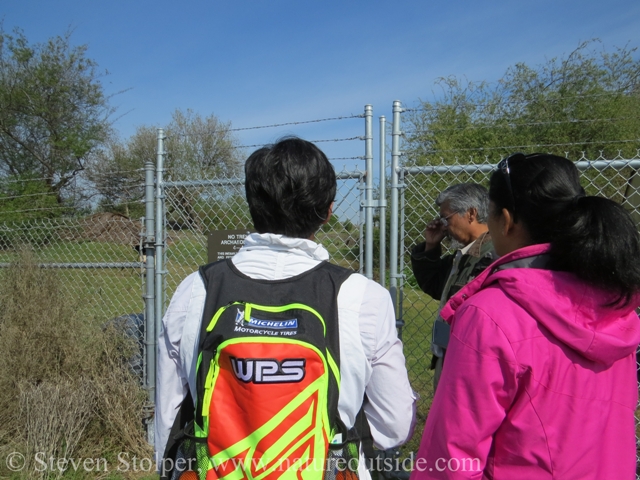
The entrance to the archaeological site.
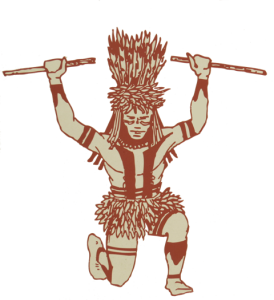 The site is ringed by a fence topped with barbed wire. Within the fence is a formidable ring of poison oak (Toxicodendron diversilobum). Usually archaeological sites are unmarked and unmentioned. But this site is well known and located adjacent to an urban area. It requires protection.
The site is ringed by a fence topped with barbed wire. Within the fence is a formidable ring of poison oak (Toxicodendron diversilobum). Usually archaeological sites are unmarked and unmentioned. But this site is well known and located adjacent to an urban area. It requires protection.
Inside the fence are three replica structures. The park was careful not to build them on the exact village site.
Preserving cultural history is an important reason to preserve and protect this site. But there is another important motivation. Descendants of the Ohlone are still among us! How would you feel if strangers disturbed the remains of your ancestors?
As part of our education, we heard stories of how people destroyed other Ohlone archaeological sites. Some were demolished to make way for shopping centers. In other cases, and I found this particularly disturbing, people sold the rich organic soil as fertilizer still containing human remains.
Today, ancient sites are still disturbed by development. But there seems to be growing sensitivity that I hope will continue.
Sweat House
The first structure we entered was the sweathouse (tupen). Sweathouses are like saunas without the steam. Men visited the sweathouse to prepare for hunting. Beside the spiritual significance, the sweating helped remove the hunter’s “human scent.” Sweathouses also served as men’s clubhouses.
Redwood bark tops the roof of this sweathouse. Normally, the bark should be completely covered with dirt. But the park chose not to do this because they worried the weight of the earth might collapse the structure.
NOTE: This is a replica and is not used for religious ceremonies.
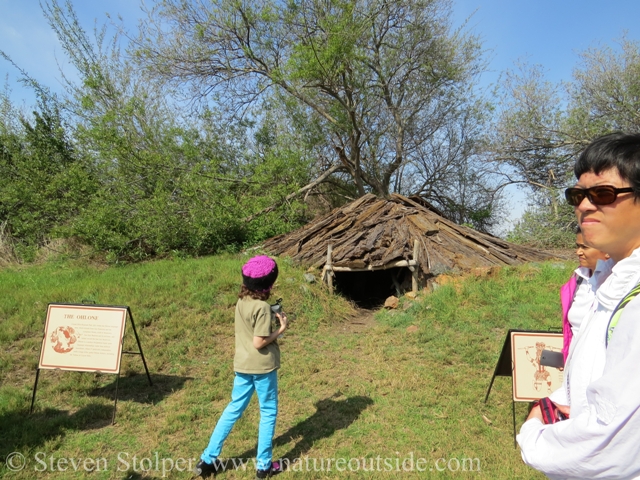
The sweathouse replica
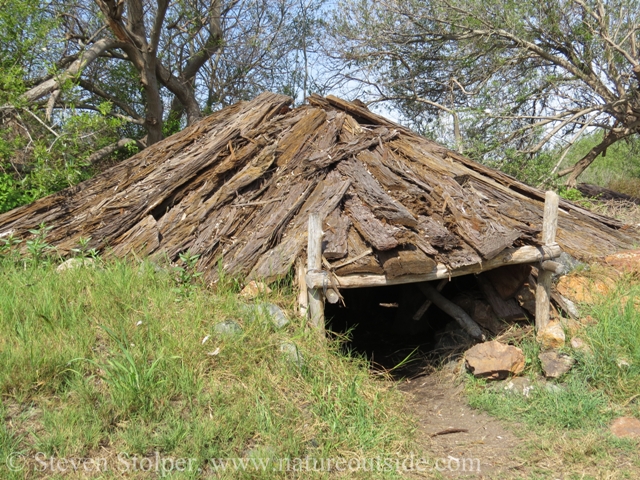
The roof should be covered by earth.
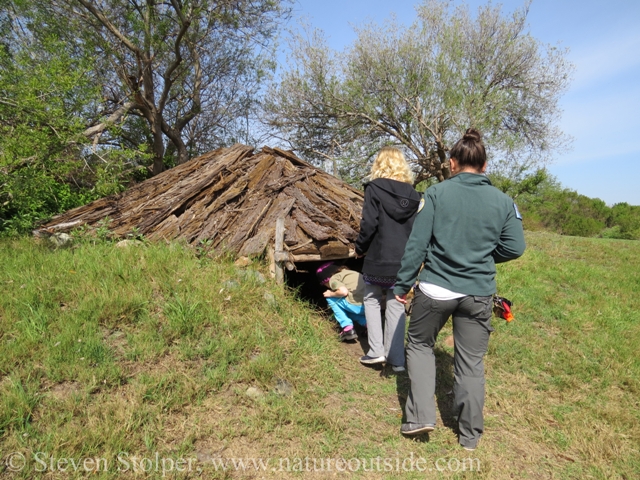
Entering the replica sweathouse required crawling through the entrance.
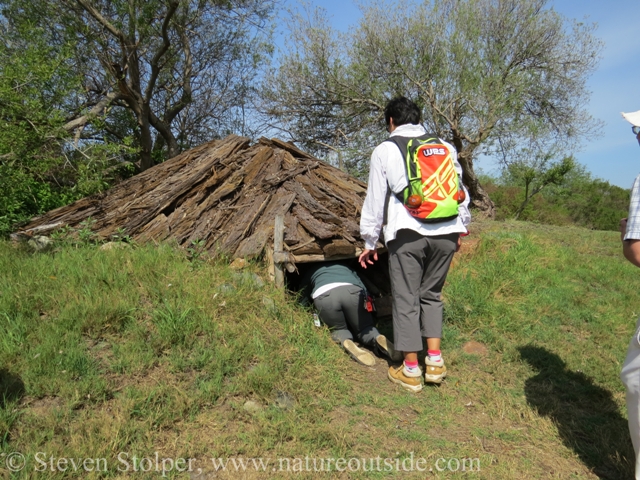
Entering the replica sweathouse.
This was the smallest one I have been inside. The central feature is a fire ring below a chimney hole in the roof.
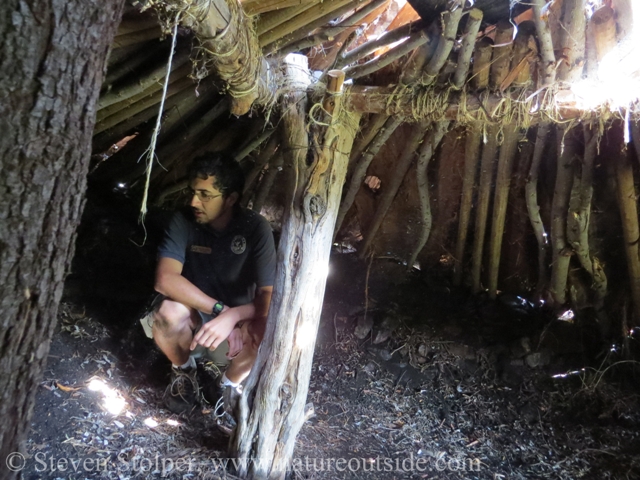
We kneeled inside the replica sweathouse
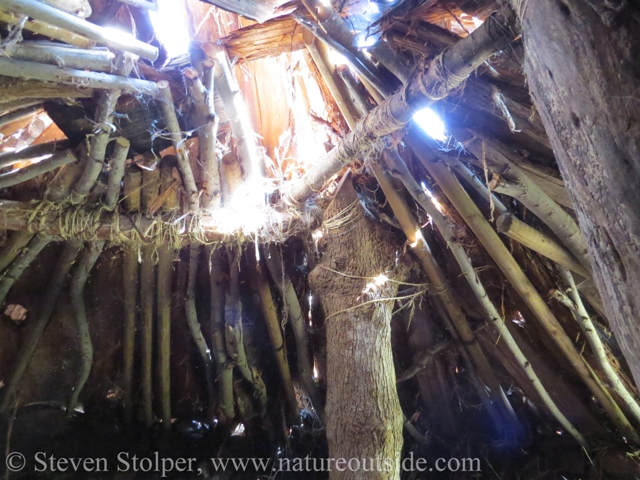
Looking toward the roof, the support structures appear to be lashed with twine.
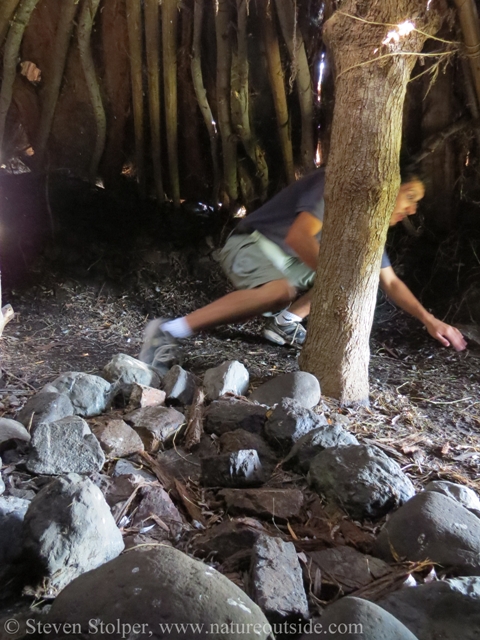
The central fire ring and one of the main supports.
After quiet discussion, we decide to explore the rest of the village. We visit a pit house and learn about ancient tools and blankets.
The Tuibun of Coyote Hills (Part 2)
Notes
Related Articles on NatureOutside
The Tuibun of Coyote Hills (Part 2)
Archaeology, Technology, and Native Peoples
If you enjoyed this article, you may like others in the Trips Section.



Thank you for the interesting article
You’re welcome, Keiko!
Thanks to your article , I immediately went and joined the docent led hike to the ohlone village site. We drove all the way from Fresno but it was well worth it. The docent lady was very knowledgeable, informative and awesome. I absolutely loved the tour !
That’s terrific, Keiko! I’m happy you had a good time.
A delightful read! So much to learn about the Tuibun people! I am looking forward to a walking tour of the archeological site some day!
I’m glad you enjoyed the article, Youkang. I think you will enjoy the tour.
8/22/22
Visited this last weekend. I can certainly see why this site was chosen for a native village.
The village site is located on a ground rise surrounded by tiles and tidal waterways. A shorty hike to adjoining sloping hill tops gives a magnificent view and access to the bay shoreline.
The climate is mild and livable year round and the wildlife must have been plentiful. Amazingly beautiful area.
I agree, Sherwood. It’s easy to see why they picked that site. It’s fun to imagine what it would be like to live in that village, so many years ago.
Thanx Steve for the interesting info. 40 years ago I explored many Native American camp sites in the San Luis Valley of southern Colorado. Most of the camps there were migrant camps as the winters were quite severe. The valley floor is at 8000 feet.
My interest in these sites go way back and it was a treat to visit the Coyote Hills site. Thanx again.